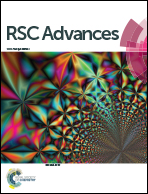Formation of zwitterionic salts via three-component reaction of benzimidazolium bromides, aromatic aldehydes and 1,3-indanedione†
Abstract
The three-component reaction of N-butyl-N′-phenacylbenzimidazolium bromide, aromatic aldehydes and 1,3-indanedione in ethanol in the presence of triethylamine as base catalyst resulted in the unusual charge-separated zwitterionic salts in good yields. Similar reactions with N-butyl-N′-(4-nitrobenzyl)- and N-butyl-N′-ethoxycarbonylmethylbenzimidazolium bromide also afforded the corresponding zwitterionic salts. Furthermore, 1H NMR spectra and single crystal structures indicated that the zwitterionic salts usually exist as two kinds of conformational isomers due to hindered interconversion of the different conformations.


 Please wait while we load your content...
Please wait while we load your content...